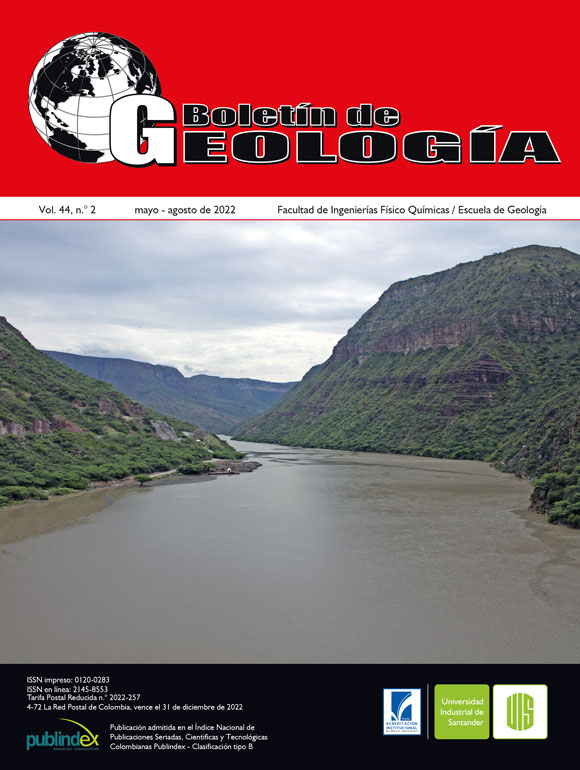Towards the elaboration of a hydrogeological model of the Guachiría river basin (Colombia)
Published 2022-07-07
Keywords
- Hydrogeology,
- Hydrology,
- Potential recharge,
- Hydrogeochemistry,
- Eastern plains
- Orinoquía ...More
How to Cite
Copyright (c) 2022 Boletín de Geología

This work is licensed under a Creative Commons Attribution 4.0 International License.
Altmetrics
Abstract
In recent years, extreme climatic variations have generated obvious effects on natural resources, harming one of the most important: water. A clear example of this is the Guachiría River Basin, located in Colombia, the prolonged dry seasons of the last decade have harmed both the biota and the civilian population, since they depend mainly on this resource. The present study aims to increase the state of the art on hydrometeorological, hydraulic variables and, in general, to understand the hydrogeological conditions of the Guachiría River Basin, this with the purpose of providing information that serves as baseline for the elaboration of a conceptual hydrogeological model (CHM) that helps in decision-making by the entities in charge of water resource management. First, the morphometric and geological conditions of the area were determined, finding that there is a predominance of flat areas with little slope, made up of unconsolidated deposits, extensive flood zones and wind influence on fluvial deposits. Then, starting from a mass balance, a water balance was carried out in the basin to quantify the resource in the area; In turn, favorable recharge zones were identified in several sectors: one part towards the foothills in the area of high slopes and another towards the deposits with eolian influence, made up of sandy and sandy loam soils that overlie the Guayabo Formation. In addition, through pumping tests, different hydraulic parameters were determined, and the aquifers were classified as free, confined, and semi-confined, linked to the lithology of the area, due to their extension and lithological complexity. Finally, a hydrogeochemical sampling was carried out, where mostly relatively young waters, with little transport and high iron content were found.
Downloads
References
- Benavides-Guerrero, C.E.; Caro-Caro, L.E.; Mariño-Martínez, J.E. (2021). Determinación del comportamiento hidráulico de los acuíferos del norte de la Orinoquia, Colombia. Ciencia e Ingeniería Neogranadina, 31(1), 109-127. https://doi.org/10.18359/rcin.4680
- Budyko, M.J. (1974). Climate and life. Academic Press.
- COLCIENCIAS-UPTC (2016). Proyecto de investigación: modelo hidrogeológico conceptual e isotópico de la sabana estacional de Paz de Ariporo, Casanare, Colombia. Contrato 005 de 2016. Proyecto.
- CORPOURABA & Universidad de Antioquia. (2016). Plan de manejo ambiental de acuífero sistema hidrogeológico golfo de Urabá. Medellín.
- Custodio, E.; Llamas, M.R. (1976). Hidrología subterránea. Tomo l. Omega Barcelona.
- EIA (2005). Estudio de Impacto Ambiental Bloque Guachiría-Caño Chiquito. Solana Petroleum. Proyecto. Centro de Información de Corporinoquía.
- Galvis, N.; Suárez, M. (1984). Geología de la cuenca de los Llanos Orientales de Colombia. Informe de Progreso N°1. Bogotá: INGEOMINAS.
- Guzmán, M. (2015). Donde se entrelazan dos mundos. Más de una razón. Revista Semana, 34-35.
- Hargreaves, G.H.; Samani, Z.A. (1985). Reference Crop Evapotranspiration from Temperature. Applied Engineering in Agriculture, 1(2), 96-99. https://doi.org/10.13031/2013.26773
- IDEAM (2014). Estudio Nacional del Agua. Instituto de Hidrología, Meteorología y Estudios Ambientales. Bogotá.
- IDEAM (2010). Leyenda Nacional de Coberturas de la Tierra. Metodología CORINE Land Cover adaptada para Colombia Escala 1:100.000. Instituto de Hidrología, Meteorología y Estudios Ambientales. Bogotá.
- IGAC (2014). Estudio General de Suelos y Zonificación de Tierras, Departamento de Casanare. Instituto Geográfico Agustín Codazzi.
- Musy, A. (2001). Cours “Hydrologie générale”. Ecole Polytechnique Fédérale de Lausanne. IATE/HYDRAM. Laboratoire d´Hydrologie et Aménagement. Capítulo 1, 2 y 3.
- PBOT (2011). Revisión y ajuste al Plan Básico de Ordenamiento Territorial de Paz de Ariporo Casanare. Alcaldía municipal de Paz de Ariporo, Acuerdo 500.02-006 de 2011.
- Poveda-Jaramillo, G.; Mesa-Sánchez, O.J.; Vélez-Upegui, J.I. (2020). Hidrología de Colombia. El ciclo del agua en una geografía compleja. Universidad Nacional de Colombia.
- Sarmiento, G.; Monasterio, M.; Silva, J. (1971). Reconocimiento ecológico de los Llanos Occidentales. Acta Científica Venezolana, 22, 52-61.
- Schosinsky, G.; Losilla, M. (2000). Modelo analítico para determinar la infiltración con base en la lluvia mensual. Revista Geológica de América Central, 23, 43-55.
- SGC. (2018). Modelo hidrogeológico conceptual del municipio de Yopal, departamento de Casanare. Grupo de Exploración de Aguas Subterráneas.
- SGC. (2012). Memoria Geológica de la Plancha 196 Río Guachiría, escala 1:100.000. Servicio Geológico Colombiano.

